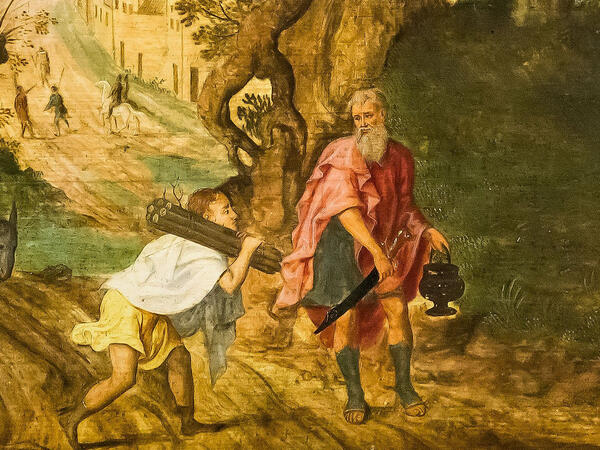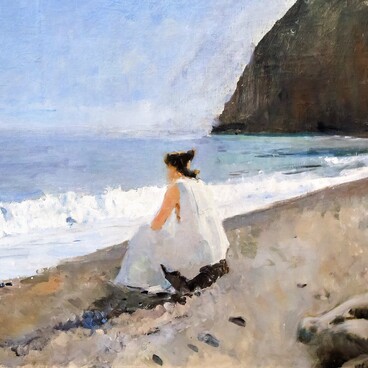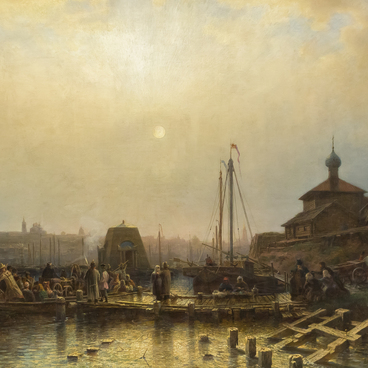‘The Seven Acts of Mercy’ is an allegorical painting. In such paintings, artists depicted abstract concepts with the help of special symbols, for example, justice could be shown as scales, while a girl with wildflowers stood for spring.
The Dutch artist Frans Francken created an allegorical painting about the seven acts of mercy described in the Bible. The Gospel of Matthew mentions six of them — feeding the hungry, giving drink to the thirsty, giving shelter to travelers, clothing the naked, visiting the sick, and visiting the imprisoned. Burying the dead — one more righteous act, described in the Old Testament — was added to this painting as well. This act was most often depicted in the late Middle Ages, especially in the 16th century, when the plague was rife in Europe.
The painting was created in the first half of the 17th century. In the foreground, Francken placed the scene ‘Giving out Bread’ which refers to the first act of mercy. It shows a wealthy married couple feeding the poor. Such scenes reminded people about piety — the most important quality of a human soul. The artist emphasized the piousness of the woman by her outfit — she wears a dress with a high collar covering her neck and chest, and her hair is demurely hidden under a headdress.
The rest of the acts of mercy are harmoniously placed in the middle and background. Francken divided the complex composition into separate scenes arranged both in the niches of the buildings and out in the open. The simple and colorful painting ‘The Seven Acts of Mercy’ was liked so highly praised by contemporaries that the artist made several copies of it. One of them is housed at the Hermitage in Saint Petersburg.
Frans Francken the Younger was a prominent Flemish painter who lived from 1581 to 1642. He painted small pictures full of curious detail. He was particularly engaged in mythological and biblical subjects that combined the pursuance of authenticity and the interest in symbolism.
Francken came from a well-known artistic family. He was the third son of the painter Frans Francken the Elder, and therefore he added ‘the Younger’ to his signature on the paintings until 1616. The artist became famous for bringing unusual subjects into the Flemish painting. In other words, in his genre paintings Francken depicted ‘new’ animals that were not present in the works of other painters before him, for example monkeys (David Teniers the Younger would later exploit the ‘monkey’ theme in his paintings). In later life, Franken created a number of altarpieces. ‘The Crucifixion’, painted in 1616 and kept in the Belvedere Palace in Vienna, is recognized as one of his best works.
The Dutch artist Frans Francken created an allegorical painting about the seven acts of mercy described in the Bible. The Gospel of Matthew mentions six of them — feeding the hungry, giving drink to the thirsty, giving shelter to travelers, clothing the naked, visiting the sick, and visiting the imprisoned. Burying the dead — one more righteous act, described in the Old Testament — was added to this painting as well. This act was most often depicted in the late Middle Ages, especially in the 16th century, when the plague was rife in Europe.
The painting was created in the first half of the 17th century. In the foreground, Francken placed the scene ‘Giving out Bread’ which refers to the first act of mercy. It shows a wealthy married couple feeding the poor. Such scenes reminded people about piety — the most important quality of a human soul. The artist emphasized the piousness of the woman by her outfit — she wears a dress with a high collar covering her neck and chest, and her hair is demurely hidden under a headdress.
The rest of the acts of mercy are harmoniously placed in the middle and background. Francken divided the complex composition into separate scenes arranged both in the niches of the buildings and out in the open. The simple and colorful painting ‘The Seven Acts of Mercy’ was liked so highly praised by contemporaries that the artist made several copies of it. One of them is housed at the Hermitage in Saint Petersburg.
Frans Francken the Younger was a prominent Flemish painter who lived from 1581 to 1642. He painted small pictures full of curious detail. He was particularly engaged in mythological and biblical subjects that combined the pursuance of authenticity and the interest in symbolism.
Francken came from a well-known artistic family. He was the third son of the painter Frans Francken the Elder, and therefore he added ‘the Younger’ to his signature on the paintings until 1616. The artist became famous for bringing unusual subjects into the Flemish painting. In other words, in his genre paintings Francken depicted ‘new’ animals that were not present in the works of other painters before him, for example monkeys (David Teniers the Younger would later exploit the ‘monkey’ theme in his paintings). In later life, Franken created a number of altarpieces. ‘The Crucifixion’, painted in 1616 and kept in the Belvedere Palace in Vienna, is recognized as one of his best works.



